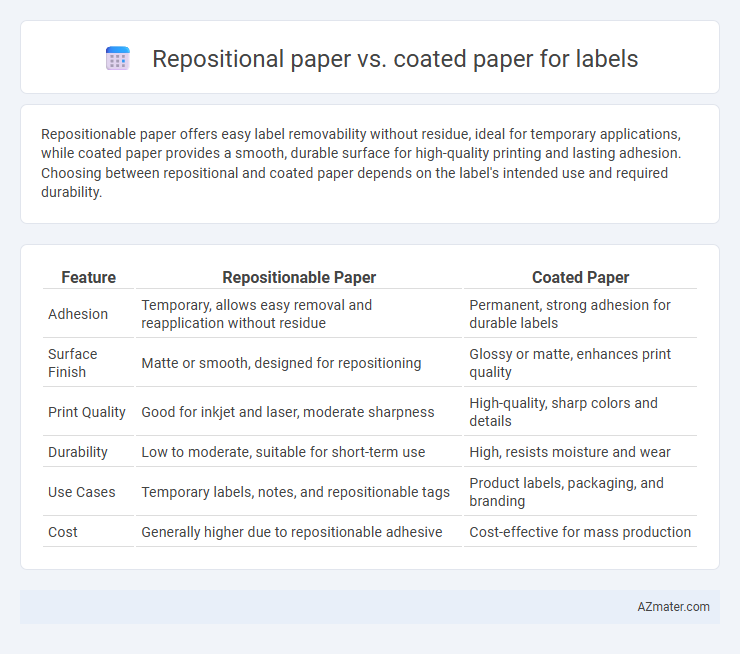Repositionable paper offers easy label removability without residue, ideal for temporary applications, while coated paper provides a smooth, durable surface for high-quality printing and lasting adhesion. Choosing between repositional and coated paper depends on the label's intended use and required durability.
Table of Comparison
| Feature | Repositionable Paper | Coated Paper |
|---|---|---|
| Adhesion | Temporary, allows easy removal and reapplication without residue | Permanent, strong adhesion for durable labels |
| Surface Finish | Matte or smooth, designed for repositioning | Glossy or matte, enhances print quality |
| Print Quality | Good for inkjet and laser, moderate sharpness | High-quality, sharp colors and details |
| Durability | Low to moderate, suitable for short-term use | High, resists moisture and wear |
| Use Cases | Temporary labels, notes, and repositionable tags | Product labels, packaging, and branding |
| Cost | Generally higher due to repositionable adhesive | Cost-effective for mass production |
Introduction to Label Paper Types
Repositional paper is designed for temporary label applications, allowing easy removal and repositioning without leaving residue, making it ideal for short-term labeling and price tags. Coated paper, typically finished with a clay or polymer layer, offers smooth surface quality and enhanced print clarity, suitable for high-resolution graphics and labels requiring durability and resistance to moisture. Understanding these distinctions helps in selecting the right label paper type based on application needs, print method, and environmental exposure.
What is Repositional Paper?
Repositional paper is a type of adhesive label material designed for temporary applications, allowing labels to be easily removed and repositioned without leaving residue or damaging surfaces. Unlike coated paper, which is treated for enhanced print quality and durability, repositional paper features a low-tack adhesive that supports repeated removal and placement, making it ideal for labeling products, packaging, and office use. Its unique adhesive properties optimize flexibility and usability, especially in scenarios that require frequent label adjustments or updates.
What is Coated Paper?
Coated paper is a type of paper that has been treated with a surface coating to improve its weight, smoothness, and printability, making it ideal for high-quality label printing. This coating typically consists of materials like clay, calcium carbonate, or latex, which enhance ink absorption and provide a glossy or matte finish. Compared to repositional paper, coated paper offers superior durability and sharp image reproduction, making it suitable for long-lasting labels that require vibrant colors and a professional appearance.
Key Features of Repositional Paper
Repositional paper for labels features a low-tack adhesive that allows easy removal and repositioning without leaving residue, making it ideal for temporary labeling and frequent updates. It is characterized by smooth surface compatibility with various printing technologies, including inkjet and laser printers, ensuring clear, sharp graphics and text. Unlike coated paper, which has a glossy or matte finish designed for permanent adhesion and enhanced durability, repositional paper prioritizes flexibility and convenience in applications such as product trials, indoor labeling, and promotional stickers.
Key Features of Coated Paper
Coated paper for labels features a smooth, sealed surface that enhances print quality by providing crisp images and vibrant colors, making it ideal for detailed graphics and high-resolution labeling. It offers improved durability and resistance to moisture, oils, and dirt, which ensures labels maintain clarity and adhesion in various environments. Unlike repositionable paper, coated paper provides a permanent bond and a professional finish, making it suitable for product labels requiring long-lasting performance.
Print Quality: Repositional vs Coated
Repositional paper for labels offers moderate print quality with good ink adhesion designed for temporary use and easy removal, but it can show slight ink smudging or lower color vibrancy compared to coated paper. Coated paper enhances print quality substantially, providing sharp, vibrant colors and well-defined images due to its smooth, sealed surface that prevents ink absorption and bleeding. Labels using coated paper achieve a professional finish ideal for high-resolution graphics and detailed text, making it the preferred choice for long-lasting, visually striking prints.
Adhesion and Removability Comparison
Repositional paper offers moderate adhesion that enables labels to be applied and repositioned several times without tearing or losing stickiness, making it ideal for temporary labeling. Coated paper, with its smooth surface and stronger adhesive properties, ensures more permanent label adhesion but typically results in lower removability and higher residue risk upon removal. Choosing between repositional and coated paper depends on the balance needed between secure attachment and clean peel-off in label applications.
Cost Differences Between the Two Paper Types
Repositional paper typically costs more than coated paper due to its specialized adhesive technology that allows for temporary application and repositioning without residue. Coated paper is generally more affordable, benefiting from simpler manufacturing processes and widespread availability for permanent labeling solutions. The higher price of repositional paper reflects its niche usage and the advanced materials required to maintain tackiness and removability.
Ideal Applications for Repositional Paper
Repositional paper is ideal for short-term labeling and temporary identification tasks in industries such as logistics, retail, and manufacturing due to its easy removability without residue. It excels in applications requiring frequent label repositioning or repositionable notes where surface integrity is crucial. This type of paper supports dynamic workflows by offering flexibility and clean removal, unlike coated paper which is better suited for permanent, durable labels with high print quality.
Best Uses for Coated Paper Labels
Coated paper labels are ideal for product packaging, branding, and promotional stickers due to their smooth surface that enhances print quality and color vibrancy. They offer excellent moisture resistance and durability, making them suitable for applications requiring high visual appeal and moderate handling. Compared to repositionable paper, coated paper labels provide a permanent adhesive solution for long-lasting label adhesion on various substrates.

Infographic: Repositional paper vs Coated paper for Label
 azmater.com
azmater.com